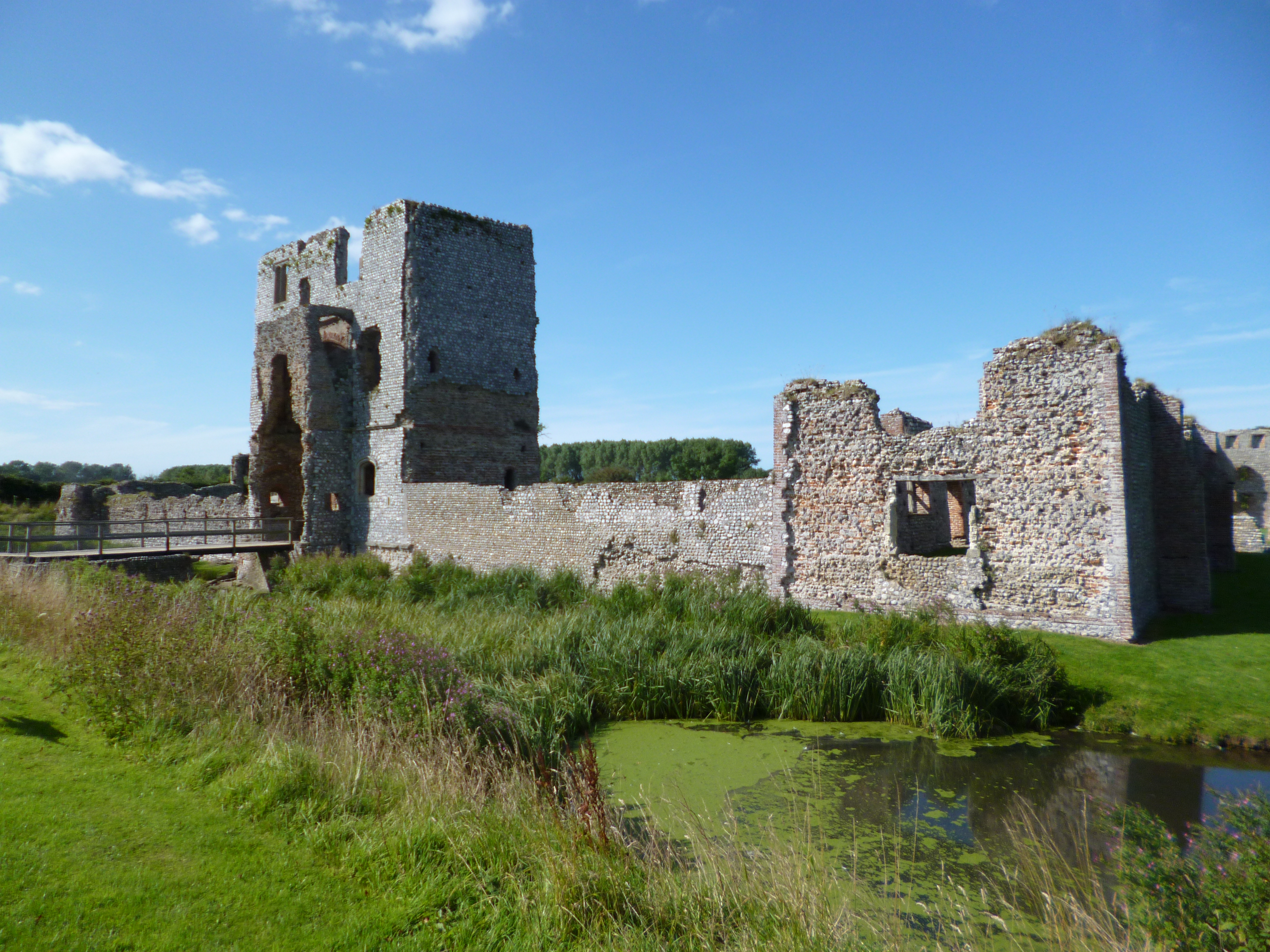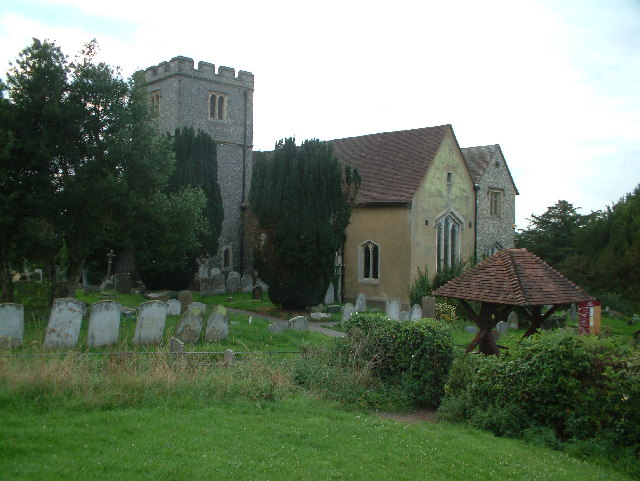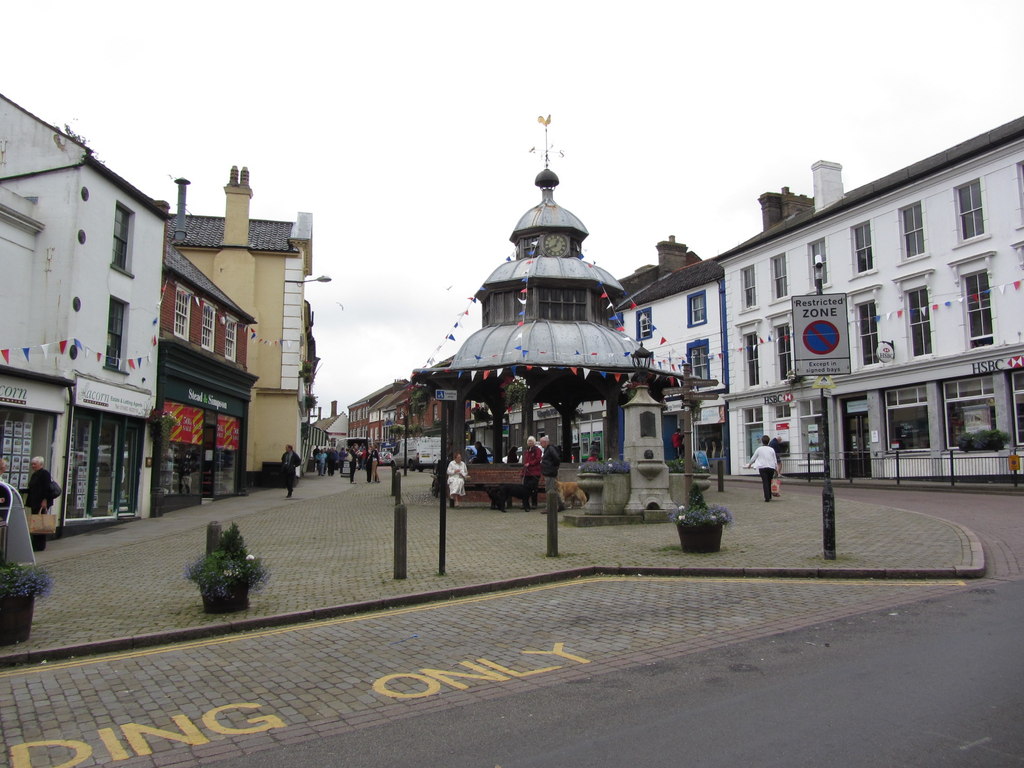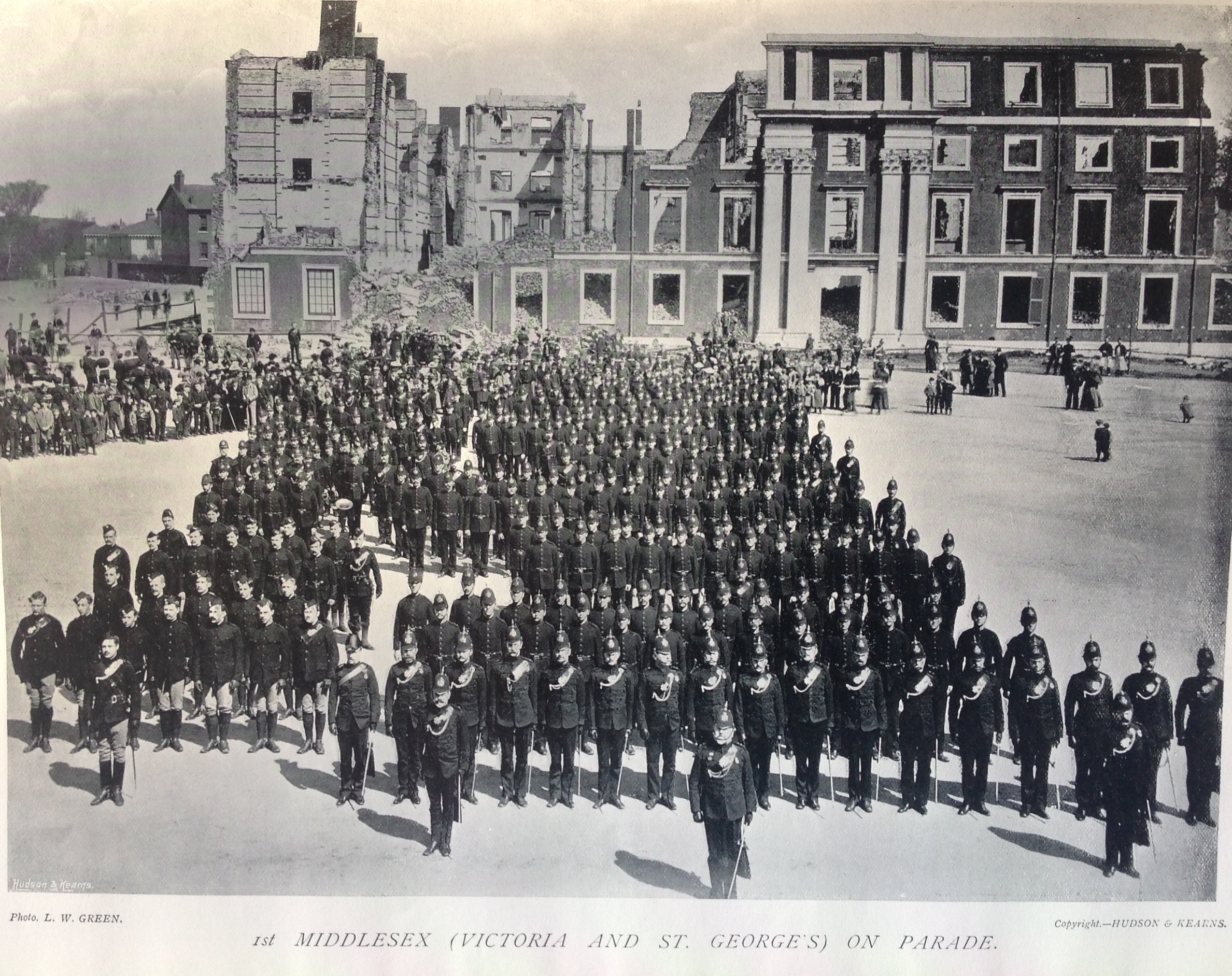|
Baconsthorpe
Baconsthorpe is a village and civil parish in the North Norfolk district of the English county of Norfolk. It is 4 miles (6 km) south-east of Holt, 5 miles (8 km) south of Sheringham and 20 miles (32 km) north of Norwich. Population and governance The civil parish has an area of 5.53 km². In the 2001 census it had a population of 232 in 105 households. This eased to 215 at the Census 2011, and was estimated at 216 in 2019. For local government, the parish is in the district of North Norfolk. Heritage The village's name derives from "Bacon's outlying farm/settlement", Bacon being the surname of the local landowner in Norman times. The ruins of the 15th-century Baconsthorpe Castle lie about one mile (1.6 km) to the north of the village. The medieval Anglican Church of St Mary was restored in 1868 and 1958. It contains monuments from the 15th–18th centuries and some 16th-century glass saved from the castle. Accommodation There is a tourist campsi ... [...More Info...] [...Related Items...] OR: [Wikipedia] [Google] [Baidu] |
Baconsthorpe Castle
Baconsthorpe Castle, historically known as Baconsthorpe Hall, is a ruined, fortified manor house near the village of Baconsthorpe, Norfolk, England. It was established in the 15th century on the site of a former manor hall, probably by John Heydon I and his father, William. John was an ambitious lawyer with many enemies and built a tall, fortified house, but his descendants became wealthy sheep farmers, and being less worried about attack, developed the property into a more elegant, courtyard house, complete with a nearby deer park. Remains By the end of the 16th century, the Heydons were spending beyond their means and the castle had to be mortgaged. Nonetheless, new formal gardens and a decorative mere were constructed alongside the house. Sir John Heydon III fought alongside the Royalists in the English Civil War and in retaliation was declared delinquent by Parliament in 1646. His fortunes did not recover and he began to demolish Baconsthorpe in 1650 in order to sell off ... [...More Info...] [...Related Items...] OR: [Wikipedia] [Google] [Baidu] |
Christopher Heydon
Sir Christopher Heydon (14 August 1561 – 1 January 1623) was an English soldier, Member of Parliament, and writer on astrology. He quarrelled with his family over its estates in Norfolk. Background Born in Surrey, Heydon was the eldest son of Sir William Heydon (1540–1594) of Baconsthorpe, Norfolk, and his wife Anne, daughter of Sir William Woodhouse of Hickling, Norfolk. The family was powerful in Norfolk affairs, owning many manors and living at Baconsthorpe Castle, a large country house in North Norfolk.Capp, Bernard, ''Heydon, Sir Christopher (1561–1623), soldier and writer on astrology'' in ''Oxford Dictionary of National Biography'' (Oxford University Press, 2004) Education Heydon was educated at Gresham's School, Holt and Peterhouse, Cambridge, where he knew the young Robert Devereux, 2nd Earl of Essex, and after graduating BA in 1579 travelled widely on the continent. Dispute with his father Deeply in debt, Heydon's father Sir William had mortgaged Bacon ... [...More Info...] [...Related Items...] OR: [Wikipedia] [Google] [Baidu] |
Henry Heydon
Sir Henry Heydon (died 1504) was the son of John Heydon of Baconsthorpe, Norfolk, 'the well-known opponent of the Paston family'. He married Anne Boleyn, the daughter of Sir Geoffrey Boleyn, great-grandfather of Henry VIII's queen Anne Boleyn Anne Boleyn (; 1501 or 1507 – 19 May 1536) was Queen of England from 1533 to 1536, as the second wife of King Henry VIII. The circumstances of her marriage and of her execution by beheading for treason and other charges made her a key .... Career Henry Heydon was the son of John Heydon (d.1479) of Baconsthorpe, Norfolk, and Eleanor Winter, the daughter of Edmund Winter (d.1448) of Barningham Hall, Barningham, Norfolk.Hundred of South Erpingham: Baconsth ... [...More Info...] [...Related Items...] OR: [Wikipedia] [Google] [Baidu] |
John Heydon (died 1479)
John Heydon ( Baxter; died 1479) of Baconsthorpe, Norfolk, was of humble origins, the son of a yeoman, William Baxter of Heydon. He became a successful lawyer, and is known, through the Paston Letters, as one of the principal agents in East Anglia of William de la Pole, 1st Duke of Suffolk, and one of the chief opponents of the Paston family. Career John was the son of a yeoman, William Baxter of Heydon, Norfolk. Legal records from as late as 1450 refer to him as 'John Heydon of Baconsthorpe alias John Baxter of Heydon'. His mother's name was Jane, daughter and heiress of John Warren, of Lincolnshire, whose arms, ''Chequey or and azure, on a canton gules, a lion rampant argent,'' is also quartered by the Heydons family; [...More Info...] [...Related Items...] OR: [Wikipedia] [Google] [Baidu] |
Robert Brightiffe
Robert Brightiffe or Britiffe (c. 1666 – 22 September 1749), of Baconsthorpe, Norfolk, was an English lawyer and Whig politician. He sat in the House of Commons from 1715 to 1734 and served as recorder of Norwich in 1737–1743. Background and education Brightiffe was born at Baconsthorpe, Norfolk, the son of Edmund Brightiffe, gentleman, and his wife Mary Longe, daughter of Robert Longe of Spixworth, Norfolk. Brightiffe was educated at Baconsthorpe, at Holt School and in Norwich. He was admitted to Gonville and Caius College, Cambridge on 24 March 1680, at the age of 16.John Venn: ''Biographical Dictionary of Gonvile and Caius College...'', Vol I (1349–1713Retrieved 19 August 2018./ref> He subsequently entered the Middle Temple on 29 May 1682, and was called to the Bar in 1688. Brightiffe married Judith Edgar, daughter of Henry Edgar of Eye, Suffolk; she died in 1705. In 1704 Brightiffe was appointed Recorder of Lynn and held the post until 1730. He married as his second wif ... [...More Info...] [...Related Items...] OR: [Wikipedia] [Google] [Baidu] |
John Baconthorpe
John Baconthorpe (also Bacon, Baco, and Bacconius) ( 1290 – 1347) was a learned English Carmelite friar and scholastic philosopher. Life John Baconthorpe was born at Baconsthorpe, Norfolk, he seems to have been the grandnephew of Roger Bacon (Brit. Mus. Add. MS. 19. 116). In youth, he joined the Carmelite Order, becoming a friarGracia, J. J. & Noone, T. B. (2003). A Companion to Philosophy in the Middle Ages. Oxford: Blackwell. pg. 338-9. at Blakeney,Pasnau, R. (2010), The Cambridge History of Medieval Philosophy, Vol. II. Cambridge. pg. 291–292. near Walsingham. He studied at Oxford and Paris. He became regent master of the theology faculty at Paris by 1323. He is believed to have taught theology at Cambridge and Oxford. Eventually, he became known as ''doctor resolutus,''Nolan, S. (2011) "John Baconthorp." Encyclopedia of Medieval Philosophy. Lagerlund: Springer, Henrik (Ed.) XXIII, 1423. though the implication of this is unclear. He was a provincial prior of Englan ... [...More Info...] [...Related Items...] OR: [Wikipedia] [Google] [Baidu] |
North Norfolk
North Norfolk is a local government district in Norfolk, England. Its council is based in Cromer. The population at the 2011 Census was 101,149. History The district was formed on 1 April 1974, under the Local Government Act 1972. It was a merger of Cromer Urban District, North Walsham Urban District, Sheringham Urban District, Wells-next-the-Sea Urban District, Erpingham Rural District, Smallburgh Rural District, and Walsingham Rural District. The district was originally to be called Pastonacres, but changed its name by resolution of the council and permission of the Secretary of State for Environment before it formally came into existence on 1 April 1974. Politics Elections to the district council are held every four years, with all of the seats on the council up for election every fourth year. The council was run by a Conservative administration, the Conservative party having gained a majority of 8 seats at the 2011 elections, which they increased to 18 at the 20 ... [...More Info...] [...Related Items...] OR: [Wikipedia] [Google] [Baidu] |
Royal Garrison Artillery
The Royal Garrison Artillery (RGA) was formed in 1899 as a distinct arm of the British Army's Royal Regiment of Artillery serving alongside the other two arms of the Regiment, the Royal Field Artillery (RFA) and the Royal Horse Artillery (RHA). The RGA were the 'technical' branch of the Royal Artillery who were responsible for much of the professionalisation of technical gunnery that was to occur during the First World War. It was originally established to man the guns of the British Empire's forts and fortresses, including coastal artillery batteries, the heavy gun batteries attached to each infantry division and the guns of the siege artillery. The RGA was amalgamated with the RFA in 1924, from which time the only two arms within the Royal Regiment of Artillery have been the Royal Artillery and the Royal Horse Artillery. Organisation The Royal Garrison Artillery came into existence as a separate entity when existing coastal defence, mountain, siege and heavy batteries of t ... [...More Info...] [...Related Items...] OR: [Wikipedia] [Google] [Baidu] |
Royal Norfolk Regiment
The Royal Norfolk Regiment was a line infantry regiment of the British Army until 1959. Its predecessor regiment was raised in 1685 as Henry Cornwall's Regiment of Foot. In 1751, it was numbered like most other British Army regiments and named the 9th Regiment of Foot. It was formed as the Norfolk Regiment in 1881 under the Childers Reforms of the British Army as the county regiment of Norfolk by merging the 9th (East Norfolk) Regiment of Foot with the local Militia and Rifle Volunteers battalions. The Norfolk Regiment fought in the First World War on the Western Front and in the Middle Eastern theatre of World War I, Middle East. After the war, the regiment became the Royal Norfolk Regiment on 3 June 1935. The regiment fought with distinction in the Second World War, in action in the Battle of France and Battle of Belgium, Belgium, the Burma campaign, Far East, and then in the invasion of, and subsequent operations in, Western Front (World War II), North-west Europe. In 195 ... [...More Info...] [...Related Items...] OR: [Wikipedia] [Google] [Baidu] |
Queen Victoria's Rifles
The 9th (County of London) Battalion, London Regiment (Queen Victoria's Rifles) was a Territorial Army infantry Infantry is a military specialization which engages in ground combat on foot. Infantry generally consists of light infantry, mountain infantry, motorized infantry & mechanized infantry, airborne infantry, air assault infantry, and marine i ... battalion of the British Army. The London Regiment (1908–1938), London Regiment was formed in 1908 in order to regiment the various Volunteer Force (Great Britain), Volunteer Force battalions in the newly formed County of London, and the Queen Victoria's Rifles were one of twenty six units brought together in this way. History Early history The Queen Victoria’s Rifles could trace their origins back to the old volunteer regiments of the Napoleonic Wars when the Duke of Cumberland's Sharpshooters were formed as a Corps of Riflemen on 5 September 1803. The regiment was raised as the 1st (Victoria Rifle Club) Middlese ... [...More Info...] [...Related Items...] OR: [Wikipedia] [Google] [Baidu] |
Alumni Cantabrigienses
''Alumni Cantabrigienses: A Biographical List of All Known Students, Graduates and Holders of Office at the University of Cambridge, from the Earliest Times to 1900'' is a biographical register of former members of the University of Cambridge which was edited by the mathematician John Venn (1834–1923) and his son John Archibald Venn (1883–1958) and published by Cambridge University Press in ten volumes between 1922 and 1953. Over 130,000 individuals are covered, with more extended biographical detail provided for post-1751 matriculants. Publication history John Venn, a fellow and later president of Caius College, Cambridge, began this huge project after completing a biographical register of members of his own college. Part I of ''Alumni Cantabrigienses'', in four volumes, covered those who matriculated at Cambridge up to 1751. Although publication was delayed by World War I, Venn lived to see the first two volumes of Part I published before his death in 1923. They were a colla ... [...More Info...] [...Related Items...] OR: [Wikipedia] [Google] [Baidu] |
Border Regiment
The Border Regiment was a line infantry regiment of the British Army, which was formed in 1881 under the Childers Reforms by the amalgamation of the 34th (Cumberland) Regiment of Foot and the 55th (Westmorland) Regiment of Foot. After service in the Second Boer War, followed by both World War I and World War II, the regiment was amalgamated with the King's Own Royal Regiment (Lancaster) into the King's Own Royal Border Regiment in 1959, which was later merged with the King's Regiment (Liverpool and Manchester) and the Queen's Lancashire Regiment to form the present Duke of Lancaster's Regiment (King's, Lancashire and Border), which continues the lineage of the Border Regiment. History 1881–1914 The regiment was formed on 1 July 1881 as part of the Childers Reforms by the amalgamation of the 34th (Cumberland) Regiment of Foot and the 55th (Westmorland) Regiment of Foot. Under the reforms, each line infantry regiment was to have a defined regimental district, with two regul ... [...More Info...] [...Related Items...] OR: [Wikipedia] [Google] [Baidu] |




%2C_St._David's%2C_Bermuda_in_2011.jpg)


